
Home - Search - Browse - Alphabetic Index: 0- 1- 2- 3- 4- 5- 6- 7- 8- 9
A- B- C- D- E- F- G- H- I- J- K- L- M- N- O- P- Q- R- S- T- U- V- W- X- Y- Z
Soyuz 7K-T
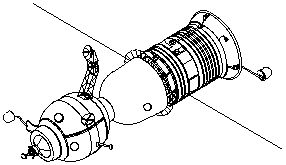 Soyuz 7K-T Credit: © Mark Wade |
AKA: 11F615A8;7K-T;7K-T/AF/. Status: Operational 1972. First Launch: 1972-06-26. Last Launch: 1981-05-14. Number: 23 . Thrust: 4.09 kN (919 lbf). Gross mass: 6,800 kg (14,900 lb). Unfuelled mass: 6,300 kg (13,800 lb). Specific impulse: 282 s. Height: 7.48 m (24.54 ft).
Following the disastrous Soyuz 11 flight, when the crew was killed by cabin depressurization, the 7K-OKS design was subjected to a complete redesign, resulting in the substantially safer 7K-T space station ferry. One crew position was eliminated, making it possible for the two crew members to wear pressure suits during dangerous phases of the flight. Batteries replaced the solar panels of the earlier configuration, to eliminate the chance of undeployed panels causing problems as was the case on Soyuz 1. Numerous minor changes were made to improve the basic safety and redundancy of the design. The 7K-T would safely fly 31 times until replaced by the Soyuz T in 1981.
Soyuz Guidance and Controls
The re-entry maneuver was normally handled automatically by radio command. Spacecraft attitude in relation to the local motion along the orbit was determined by sun sensors, infrared horizon sensors and ion gauges, which could detect the spacecraft's direction of motion by the greater velocity of ions impacting the spacecraft in the direction of motion.
The cosmonaut could however take manual control of the spacecraft and manually re-enter. This was done by using the ingenious Vzor periscope device. This had a central view and eight ports arranged in a circle around the center. When the spacecraft was perfectly centered in respect to the horizon, all eight of the ports would be lit up. Alignment along the orbit was judged by getting lines on the main scope to be aligned with the landscape flowing by below. In this way, the spacecraft could be oriented correctly for the re-entry maneuver.
To decide when to re-enter, the cosmonaut had a little clockwork globe that showed current position over the earth. By pushing a button to the right of the globe, it would be advanced to the landing position assuming a standard re-entry at that moment.
This manual system would obviously only be used during daylight portions of the orbit. At night the dark mass of the earth could not have been lined up with the optical Vzor device. The automatic system would work day or night. However problems were found on Soyuz 1 when the ion gauges would not function in ion 'pockets' of low density in the re-entry maneuver portion of the orbit.
The Soyuz kept (to this day) the little globe and Vzor system. On the early model Soyuz, prior to the Soyuz T of the 1980's, there was no on-board inertial navigation system. To perform an orbital maneuver, the parameters for an orbital maneuver would be transmitted from the ground. When the time came for a maneuver, the spacecraft would align itself to the local vertical and direction of motion by the methods mentioned above (automatic or manual). Then three gyros would be spun up, the spacecraft maneuvered automatically or manually to the required attitude for the maneuver, and the main engine would fire automatically at the prescribed time to make the orbit change. There was a simple delta-v gauge showing the velocity change. Since the Soyuz thrust to weight was so low (around 0.06, or only half a meter per second) this meant the maneuvers could be handled manually without much error (on re-entry burns the practice was to count to five after the engine was supposed to shut off before overriding it!)
The Soyuz had always had very limited maneuver capability, a source of some embarrassment during the ASTP joint flight where the Apollo did most of the maneuvering. Not until the Soyuz T version was enough maneuvering fuel and the inertial navigation system available to allow rendezvous with non-co-operative objects (like the dead Salyut 7 station on the epic Soyuz T-15 flight) and to fly around objects for inspection (this was theoretically possible in the old models, but due to limited fuel or conservatism it was never demonstrated).
Crew Size: 2. Orbital Storage: 110 days. Habitable Volume: 11.00 m3. Spacecraft delta v: 210 m/s (680 ft/sec). Electric System: 0.84 average kW.
More at: Soyuz 7K-T.
Family: Manned spacecraft, Space station orbit. Country: Russia. Engines: KTDU-35. Spacecraft: Soyuz 7K-T SA, Soyuz 7K-T BO, Soyuz 7K-T PAO, Salyut 6. Flights: Soyuz 12, Soyuz 13, Soyuz 17, Soyuz 18-1, Soyuz 18, Soyuz 25. Launch Vehicles: R-7, Soyuz 11A511, Soyuz-U. Propellants: Nitric acid/Hydrazine. Projects: Salyut. Launch Sites: Baikonur, Baikonur LC1, Baikonur LC31. Agency: Korolev bureau, MOM. Bibliography: 121, 185, 186, 187, 188, 2, 21, 32, 33, 344, 367, 382, 42, 474, 51, 6, 60, 89, 94, 6901, 13130, 13131.
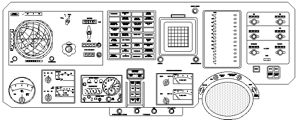 | Panel Soyuz 7K-OK Control panel of the initial earth orbit version of Soyuz. Credit: © Mark Wade |
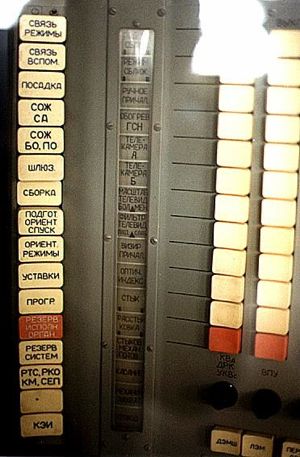 | Soyuz 7K-T Panel Close-up of Soyuz 7K-T right sequencer panel Credit: © Mark Wade |
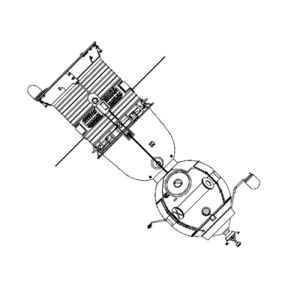 | Soyuz 7K-T Credit: © Mark Wade |
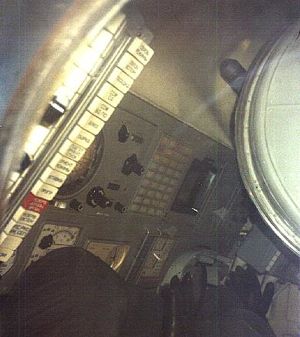 | Soyuz Interior View of Soyuz interior. Credit: © Mark Wade |
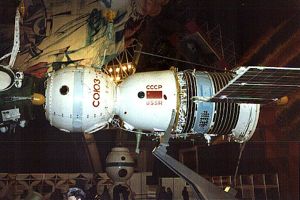 | Soyuz 7K-T Credit: © Mark Wade |
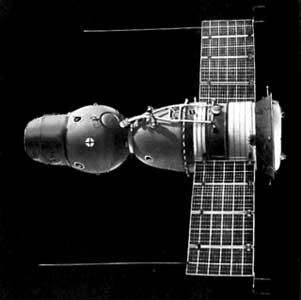 | Soyuz 13 Credit: Manufacturer Image |
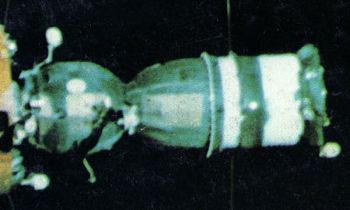 | Soyuz 12 Credit: Manufacturer Image |
1970 February 9 - .
- Salyut project begins. - . Nation: Russia. Spacecraft: Almaz OPS, Salyut 1, Soyuz 7K-T. Ministry of General Machine Building (MOM) Decree 105-41 'On creation of the DOS using Almaz as a basis' was issued..
1970 February 16 - .
- Salyut crash program authorised. - . Nation: Russia. Spacecraft: Almaz OPS, Salyut 1, Soyuz 7K-T. Decree 57ss 'On creation of the DOS using Almaz as a basis' was issued..
1971 July 4 - . Launch Vehicle: N1.
- Soyuz 11 failure investigation - .
Nation: Russia.
Related Persons: Dobrovolsky,
Patsayev,
Severin,
Tereshkova,
Volkov.
Program: Lunar L3,
Salyut.
Flight: Soyuz 11.
Spacecraft: Soyuz 7K-T,
Soyuz 7KT-OK.
This was a very difficult time for TsKBEM. All work at the bureaus came to a complete halt after the loss of Soyuz 11 and N1 6L. Simultaneous expert commissions investigated the loss of N1 6L and Soyuz 11. TsKBEM was seen as responsible for every failure. A virtually legal process ensued to fix guilt. Every design decision was examined and questioned. Additional Details: here....
1972 January 1 - .
- TsKBEM reorganised - .
Nation: Russia.
Related Persons: Bushuyev,
Dorofeyev,
Mishin,
Semenov,
Shabarov.
Program: Lunar L3,
Soyuz,
Almaz.
Spacecraft: LK,
Mars 5NM,
MKBS,
Soyuz 7K-LOK,
Soyuz 7K-OK,
Soyuz 7K-S,
Soyuz 7K-T,
Soyuz 7K-TM.
TsKBEM was given a completely new structure as a result of the findings of the expert commissions on the disasters for the previous year, Mishin remained as the Chief Designer for the organisation, but each programme now had its own chief designer:
- N1: Boris Dorofeyev
- 8K98P solid propellant ICBM: Igor Sadovskiy
- N1 payloads: Vladimir Brorov [check]
- Soyuz 7K-TM, or Soyuz M, for Soyuz-Apollo: Konstantin Bushuyev
- Soyuz 7K-T: Yuri Semenov
- Soyuz 7K-S or Soyuz VI: Yevgeni Shabarov
1972 June 26 - . 14:53 GMT - . Launch Site: Baikonur. Launch Complex: Baikonur LC1. LV Family: R-7. Launch Vehicle: Soyuz 11A511.
- Cosmos 496 - . Payload: Soyuz 7K-T s/n 33L. Mass: 6,675 kg (14,715 lb). Nation: Russia. Agency: MOM. Program: Salyut. Class: Manned. Type: Manned spacecraft. Spacecraft Bus: Soyuz. Spacecraft: Soyuz 7K-T. Duration: 9.95 days. Decay Date: 1972-07-02 . USAF Sat Cat: 6066 . COSPAR: 1972-045A. Apogee: 253 km (157 mi). Perigee: 176 km (109 mi). Inclination: 51.50 deg. Period: 88.70 min. Recovered July 6, 1972 13:54 GMT. Soyuz 7K-T redesign test..
1972 August - .
- Soyuz 12 / DOS 2 (cancelled) - . Crew: Kubasov, Leonov. Backup Crew: Lazarev, Makarov. Support Crew: Grechko, Gubarev. Nation: Russia. Program: Salyut. Flight: Soyuz 12 / DOS 2. Spacecraft Bus: Soyuz. Spacecraft: Soyuz 7K-T. Planned first mission to the Salyut DOS 2 space station. Cancelled after it was destroyed during launch..
1972 October - .
- Soyuz 13 / DOS 2 (cancelled) - . Crew: Lazarev, Makarov. Backup Crew: Grechko, Gubarev. Support Crew: Klimuk, Sevastyanov. Nation: Russia. Program: Salyut. Flight: Soyuz 13 / DOS 2. Spacecraft Bus: Soyuz. Spacecraft: Soyuz 7K-T. Planned second mission to the Salyut DOS 2 space station. Cancelled after it was destroyed during launch..
1973 June - .
- Soyuz 12 / DOS 3 (cancelled) - . Crew: Kubasov, Leonov. Backup Crew: Lazarev, Makarov. Support Crew: Grechko, Gubarev. Nation: Russia. Program: Salyut. Flight: Soyuz 12 / DOS 3. Spacecraft Bus: Soyuz. Spacecraft: Soyuz 7K-T. Planned first mission to the Salyut DOS 3 space station (Cosmos 557). Cancelled after it failed in orbit..
1973 June - .
- Soyuz (Almaz) 12 (cancelled) - . Crew: Artyukhin, Popovich. Backup Crew: Volynov, Zholobov. Nation: Russia. Program: Almaz. Flight: Soyuz (Almaz) 12. Spacecraft Bus: Soyuz. Spacecraft: Soyuz 7K-T. Planned first crew to the first Almaz space station. Cancelled after the loss of control of Almaz OPS 1 (Salyut 2) in orbit..
1973 June 15 - . 06:00 GMT - . Launch Site: Baikonur. Launch Complex: Baikonur LC1. LV Family: R-7. Launch Vehicle: Soyuz 11A511.
- Cosmos 573 - . Payload: Soyuz 7K-T s/n 35. Mass: 6,675 kg (14,715 lb). Nation: Russia. Agency: MOM. Program: Salyut. Class: Manned. Type: Manned spacecraft. Spacecraft Bus: Soyuz. Spacecraft: Soyuz 7K-T. Duration: 2.00 days. Decay Date: 1973-06-17 . USAF Sat Cat: 6694 . COSPAR: 1973-041A. Apogee: 308 km (191 mi). Perigee: 191 km (118 mi). Inclination: 51.60 deg. Period: 89.50 min. Soyuz test flight. Recovered June 17, 1973 6:01 GMT. Soyuz 7K-T redesign test, probably using one of the spacecraft allocated to the failed Salyut 2 or Cosmos 557 stations..
1973 August - .
- Soyuz (Almaz) 13 (cancelled) - . Crew: Demin, Sarafanov. Backup Crew: Rozhdestvensky, Zudov. Nation: Russia. Program: Almaz. Flight: Soyuz (Almaz) 13. Spacecraft Bus: Soyuz. Spacecraft: Soyuz 7K-T. Planned second crew to the first Almaz space station. Cancelled after the loss of control of Almaz OPS 1 (Salyut 2) in orbit..
1973 September - .
- Soyuz 13 / DOS 3 (cancelled) - . Crew: Lazarev, Makarov. Backup Crew: Grechko, Gubarev. Support Crew: Klimuk, Sevastyanov. Nation: Russia. Program: Salyut. Flight: Soyuz 13 / DOS 3. Spacecraft Bus: Soyuz. Spacecraft: Soyuz 7K-T. Planned second mission to the Salyut DOS 3 space station (Cosmos 557). Cancelled after it failed in orbit..
1973 September 27 - . 12:18 GMT - . Launch Site: Baikonur. Launch Complex: Baikonur LC1. LV Family: R-7. Launch Vehicle: Soyuz 11A511.
- Soyuz 12 - .
Call Sign: Ural (Urals ). Crew: Lazarev,
Makarov.
Backup Crew: Grechko,
Gubarev.
Support Crew: Klimuk,
Sevastyanov.
Payload: Soyuz 7K-T s/n 36. Mass: 6,720 kg (14,810 lb). Nation: Russia.
Agency: MOM.
Program: Salyut.
Class: Manned.
Type: Manned spacecraft. Flight: Soyuz 12.
Spacecraft Bus: Soyuz.
Spacecraft: Soyuz 7K-T.
Duration: 1.97 days. Decay Date: 1973-09-29 . USAF Sat Cat: 6836 . COSPAR: 1973-067A. Apogee: 348 km (216 mi). Perigee: 306 km (190 mi). Inclination: 51.00 deg. Period: 91.00 min.
Experimental flight for the purpose of further development of manned space craft Soyuz 7K-T modifications. After the Soyuz 11 disaster, the Soyuz underwent redesign for increased reliability. Two solo test flights of the new design were planned. Crews for the first flight were those already planned for the deferred follow-on missions to the failed DOS 2 and DOS 3 space stations.
1973 November 30 - . 05:20 GMT - . Launch Site: Baikonur. Launch Complex: Baikonur LC1. LV Family: R-7. Launch Vehicle: Soyuz 11A511.
- Cosmos 613 - . Payload: Soyuz 7K-T s/n 34L. Mass: 6,675 kg (14,715 lb). Nation: Russia. Agency: MOM. Program: Salyut. Class: Manned. Type: Manned spacecraft. Spacecraft Bus: Soyuz. Spacecraft: Soyuz 7K-T. Duration: 60.00 days. Decay Date: 1974-01-29 . USAF Sat Cat: 6957 . COSPAR: 1973-096A. Apogee: 276 km (171 mi). Perigee: 199 km (123 mi). Inclination: 51.60 deg. Period: 89.30 min. Unmanned Soyuz test flight. Recovered January 29, 1974 5:29 GMT. Soyuz 7K-T duration test..
1973 December 18 - . 11:55 GMT - . Launch Site: Baikonur. Launch Complex: Baikonur LC1. LV Family: R-7. Launch Vehicle: Soyuz 11A511.
- Soyuz 13 - .
Call Sign: Kavkas (Caucasus ). Crew: Klimuk,
Lebedev.
Backup Crew: Vorobyov,
Yazdovsky.
Payload: Soyuz 7K-T s/n 33A. Mass: 6,560 kg (14,460 lb). Nation: Russia.
Agency: MOM.
Program: Salyut.
Class: Manned.
Type: Manned spacecraft. Flight: Soyuz 13.
Spacecraft Bus: Soyuz.
Spacecraft: Soyuz 7K-T.
Duration: 7.87 days. Decay Date: 1973-12-26 . USAF Sat Cat: 6982 . COSPAR: 1973-103A. Apogee: 247 km (153 mi). Perigee: 188 km (116 mi). Inclination: 51.60 deg. Period: 88.80 min.
A unique flight of the 7K-T/AF modification of the Soyuz spacecraft. The orbital module was dominated by the large Orion 2 astrophysical camera. The crew conducted astrophysical observations of stars in the ultraviolet range. Additional experiments included spectrozonal photography of specific areas of the earth's surface, and continued testing of space craft's on-board systems.
1974 October - .
- Soyuz 16A (cancelled) - . Crew: Volynov, Zholobov. Backup Crew: Rozhdestvensky, Zudov. Nation: Russia. Program: Salyut. Flight: Soyuz 16A. Spacecraft Bus: Soyuz. Spacecraft: Soyuz 7K-T. Planned but cancelled third mission to the Salyut 3 space station..
1975 January 10 - . 21:43 GMT - . Launch Site: Baikonur. Launch Complex: Baikonur LC1. LV Family: R-7. Launch Vehicle: Soyuz 11A511.
- Soyuz 17 - . Call Sign: Zenit (Zenith ). Crew: Grechko, Gubarev. Backup Crew: Lazarev, Makarov. Support Crew: Klimuk, Sevastyanov. Payload: Soyuz 7K-T s/n 38. Mass: 6,800 kg (14,900 lb). Nation: Russia. Agency: MOM. Program: Salyut. Class: Manned. Type: Manned spacecraft. Flight: Soyuz 17. Spacecraft Bus: Soyuz. Spacecraft: Soyuz 7K-T. Duration: 29.56 days. Decay Date: 1975-02-09 . USAF Sat Cat: 7604 . COSPAR: 1975-001A. Apogee: 249 km (154 mi). Perigee: 185 km (114 mi). Inclination: 51.60 deg. Period: 88.80 min. Manned two crew. Docked with Salyut 4. Joint experiments with the Salyut scientific orbital station..
1975 April 5 - . 11:04 GMT - . Launch Site: Baikonur. Launch Complex: Baikonur LC1. LV Family: R-7. Launch Vehicle: Soyuz 11A511. FAILURE: During second-third stage separation third stage failed to separate from second stage but still ignited.. Failed Stage: 3.
- Soyuz 18-1 - .
Call Sign: Ural (Urals ). Crew: Lazarev,
Makarov.
Backup Crew: Klimuk,
Sevastyanov.
Payload: Soyuz 7K-T s/n 39. Mass: 6,830 kg (15,050 lb). Nation: Russia.
Agency: RVSN.
Program: Salyut.
Class: Manned.
Type: Manned spacecraft. Flight: Soyuz 18-1.
Spacecraft Bus: Soyuz.
Spacecraft: Soyuz 7K-T.
Duration: 0.0149 days. Decay Date: 1975-04-05 . Apogee: 192 km (119 mi).
Carried Oleg Makarov, Vasili Lazarev for rendezvous with Salyut 4; but during second-third stage seperation third stage failed to separate from second stage but still ignited. The crew demanded that the abort procedures be implemented but ground control could not see the launch vehicle gyrations in their telemetry. Soyuz finally was separated from by ground control command at 192 km, and following a 20.6+ G reentry, the capsule landed in the Altai mountains, tumbled down a mountainside, and snagged in some bushes just short of a precipice. The crew was worried that they may have landed in China and would face internment, but after an hour sitting in the cold next to the capsule, they were discovered by locals speaking Russian. Total flight duration was 1574 km and flight time 21 minutes 27 seconds. Lazarev suffered internal injuries from the high-G reentry and tumble down the mountain side and never flew again. Both cosmonauts were denied their 3000 ruble spaceflight bonus pay and had to apeal all the way to Brezhnev before being paid.
1975 May 24 - . 14:58 GMT - . Launch Site: Baikonur. Launch Complex: Baikonur LC1. LV Family: R-7. Launch Vehicle: Soyuz 11A511.
- Soyuz 18 - . Call Sign: Kavkas (Caucasus ). Crew: Klimuk, Sevastyanov. Backup Crew: Kovalyonok, Ponomaryov. Payload: Soyuz 7K-T s/n 40. Mass: 6,825 kg (15,046 lb). Nation: Russia. Agency: MOM. Program: Salyut. Class: Manned. Type: Manned spacecraft. Flight: Soyuz 18. Spacecraft Bus: Soyuz. Spacecraft: Soyuz 7K-T. Duration: 62.97 days. Decay Date: 1975-07-26 . USAF Sat Cat: 7818 . COSPAR: 1975-044A. Apogee: 230 km (140 mi). Perigee: 186 km (115 mi). Inclination: 51.70 deg. Period: 88.60 min. Manned two crew. Docked with Salyut 4. Joint experiments with the Salyut scientific orbital station. The crew remained aloft aboard the station during the Apollo-Soyuz Test Project joint flight..
1977 July - .
- Soyuz 25A (cancelled) - .
Crew: Berezovoi,
Lisun.
Backup Crew: Kozelsky,
Preobrazhensky.
Nation: Russia.
Related Persons: Chelomei,
Glushko.
Program: Almaz.
Flight: Soyuz 25A.
Spacecraft Bus: Soyuz.
Spacecraft: Soyuz 7K-T.
A Soyuz 25 mission to the Salyut 5 space station with the crew of Berzovoi and Lisun was to have followed Soyuz 24. However during the four months it took to prepare the Soyuz, Salyut 5 consumed higher than expected fuel in maintaining the station's orientation. The flight was cancelled and the spacecraft allocated for Soyuz 25 flew as Soyuz 30 to Glushko's civilian Salyut station.
1977 October 9 - . 02:40 GMT - . Launch Site: Baikonur. Launch Complex: Baikonur LC1. LV Family: R-7. Launch Vehicle: Soyuz-U.
- Soyuz 25 - . Call Sign: Foton (Photon). Crew: Kovalyonok, Ryumin. Backup Crew: Ivanchenkov, Romanenko. Payload: Soyuz 7K-T s/n 42. Mass: 6,860 kg (15,120 lb). Nation: Russia. Agency: MOM. Program: Salyut 6. Class: Manned. Type: Manned spacecraft. Flight: Soyuz 25. Spacecraft Bus: Soyuz. Spacecraft: Soyuz 7K-T. Duration: 2.03 days. Decay Date: 1977-10-11 . USAF Sat Cat: 10401 . COSPAR: 1977-099A. Apogee: 240 km (140 mi). Perigee: 194 km (120 mi). Inclination: 51.60 deg. Period: 88.80 min. Manned two crew. Unsuccessful mission. Failed to dock with Salyut 6..
1977 November - .
- Soyuz 26A (cancelled) - .
Crew: Dzhanibekov,
Kolodin.
Backup Crew: Lazarev,
Makarov.
Nation: Russia.
Program: Salyut.
Flight: Soyuz 26A.
Spacecraft Bus: Soyuz.
Spacecraft: Soyuz 7K-T.
Planned mission to Salyut 6 that would make first docking with rear docking port and be the first crew to swap spacecraft and return in the spacecraft that ferried the Soyuz 25 crew. But after Soyuz 25 failed to dock with Salyut 6 and Soyuz 26 as finally flown had quite a different crew and mission profile.
1977 December 10 - . 01:18 GMT - . Launch Site: Baikonur. Launch Complex: Baikonur LC1. LV Family: R-7. Launch Vehicle: Soyuz-U.
- Soyuz 26 - . Call Sign: Taimyr (Taimyr - Russian peninsula). Crew: Grechko, Romanenko. Backup Crew: Ivanchenkov, Kovalyonok. Payload: Soyuz 7K-T s/n 43. Mass: 6,800 kg (14,900 lb). Nation: Russia. Agency: MOM. Program: Salyut 6. Class: Manned. Type: Manned spacecraft. Flight: Soyuz 26. Spacecraft Bus: Soyuz. Spacecraft: Soyuz 7K-T. Duration: 37.42 days. Decay Date: 1978-01-16 . USAF Sat Cat: 10506 . COSPAR: 1977-113A. Apogee: 235 km (146 mi). Perigee: 205 km (127 mi). Inclination: 51.60 deg. Period: 88.80 min. Manned two crew. Docked with Salyut 6. Carried Yuri Romanenko, Georgi Grechko to Salyut 6; returned crew of Soyuz 27 to Earth. Conduct of joint experiments with the Salyut-6 scientific station..
1978 January 10 - . 12:26 GMT - . Launch Site: Baikonur. Launch Complex: Baikonur LC1. LV Family: R-7. Launch Vehicle: Soyuz-U.
- Soyuz 27 - . Call Sign: Pamir (Pamir mountains). Crew: Dzhanibekov, Makarov. Backup Crew: Ivanchenkov, Kovalyonok. Payload: Soyuz 7K-T s/n 44. Mass: 6,800 kg (14,900 lb). Nation: Russia. Agency: MOM. Program: Salyut 6. Class: Manned. Type: Manned spacecraft. Flight: Soyuz 26, Soyuz 27. Spacecraft Bus: Soyuz. Spacecraft: Soyuz 7K-T. Duration: 64.95 days. Decay Date: 1978-03-16 . USAF Sat Cat: 10560 . COSPAR: 1978-003A. Apogee: 237 km (147 mi). Perigee: 190 km (110 mi). Inclination: 51.70 deg. Period: 88.70 min. Manned two crew. Carried Oleg Makarov, Vladimir Dzhanibekov to Salyut 6; returned crew of Soyuz 26 to Earth. Docked with Salyut 6..
1978 March 2 - . 15:28 GMT - . Launch Site: Baikonur. Launch Complex: Baikonur LC1. LV Family: R-7. Launch Vehicle: Soyuz-U.
- Soyuz 28 - .
Call Sign: Zenit (Zenith ). Crew: Gubarev,
Remek.
Backup Crew: Pelczak,
Rukavishnikov.
Payload: Soyuz 7K-T s/n 45. Mass: 6,800 kg (14,900 lb). Nation: Russia.
Agency: MOM.
Program: Salyut 6.
Class: Manned.
Type: Manned spacecraft. Flight: Soyuz 26,
Soyuz 28.
Spacecraft Bus: Soyuz.
Spacecraft: Soyuz 7K-T.
Duration: 7.93 days. Decay Date: 1978-03-10 . USAF Sat Cat: 10694 . COSPAR: 1978-023A. Apogee: 246 km (152 mi). Perigee: 192 km (119 mi). Inclination: 51.60 deg. Period: 88.80 min.
Manned two crew. Docked with Salyut 6. Delivery to the Salyut-6 station of the first international 'Intercosmos' team consisting of A.A. Gubarev (USSR) and V. Remek (Czechoslovak Socialist Republic) to carry out scientific research and experiments jointly developed by Soviet a nd Czechoslovak specialists.
1978 June 15 - . 20:16 GMT - . Launch Site: Baikonur. Launch Complex: Baikonur LC1. LV Family: R-7. Launch Vehicle: Soyuz-U.
- Soyuz 29 - . Call Sign: Foton (Photon). Crew: Ivanchenkov, Kovalyonok. Backup Crew: Lyakhov, Ryumin. Payload: Soyuz 7K-T s/n 46. Mass: 6,800 kg (14,900 lb). Nation: Russia. Agency: MOM. Program: Salyut 6. Class: Manned. Type: Manned spacecraft. Flight: Soyuz 29. Spacecraft Bus: Soyuz. Spacecraft: Soyuz 7K-T. Duration: 79.64 days. Decay Date: 1978-09-03 . USAF Sat Cat: 10952 . COSPAR: 1978-061A. Apogee: 248 km (154 mi). Perigee: 193 km (119 mi). Inclination: 51.60 deg. Period: 88.90 min. Manned two crew. Docked with Salyut 6. Placed on board the Salyut-6 station a crew consisting of V.V. Kovalenko and A.S. Ivanchenkov to conduct scientific and technological investigations and experiments..
1978 August 26 - . 14:51 GMT - . Launch Site: Baikonur. Launch Complex: Baikonur LC1. LV Family: R-7. Launch Vehicle: Soyuz-U.
- Soyuz 31 - . Call Sign: Yastreb (Hawk ). Crew: Bykovsky, Jaehn. Backup Crew: Gorbatko, Koellner. Payload: Soyuz 7K-T s/n 47. Mass: 6,800 kg (14,900 lb). Nation: Russia. Agency: MOM. Program: Salyut 6. Class: Manned. Type: Manned spacecraft. Flight: Soyuz 29, Soyuz 31. Spacecraft Bus: Soyuz. Spacecraft: Soyuz 7K-T. Duration: 67.84 days. Decay Date: 1978-11-02 . USAF Sat Cat: 11010 . COSPAR: 1978-081A. Apogee: 243 km (150 mi). Perigee: 193 km (119 mi). Inclination: 51.60 deg. Period: 88.80 min. Manned two crew. Docked with Salyut 6. Delivered to the Salyut-6 station the third international 'Intercosmos' crew consisting of V F Bykovsky (USSR) and S Jaehn (German Democratic Republic) to carry out scientific research and experiments..
1979 February 25 - . 11:53 GMT - . Launch Site: Baikonur. Launch Complex: Baikonur LC31. LV Family: R-7. Launch Vehicle: Soyuz-U.
- Soyuz 32 - . Call Sign: Proton (Proton ). Crew: Lyakhov, Ryumin. Backup Crew: Lebedev, Popov. Payload: Soyuz 7K-T s/n 48. Mass: 6,800 kg (14,900 lb). Nation: Russia. Agency: MOM. Program: Salyut 6. Class: Manned. Type: Manned spacecraft. Flight: Soyuz 32. Spacecraft Bus: Soyuz. Spacecraft: Soyuz 7K-T. Duration: 110.18 days. Decay Date: 1979-06-13 . USAF Sat Cat: 11281 . COSPAR: 1979-018A. Apogee: 256 km (159 mi). Perigee: 193 km (119 mi). Inclination: 51.60 deg. Period: 88.90 min. Manned two crew. Docked with Salyut 6. Transported a team consisting of V A Lyakhov and V V Ryumin to the Salyut-6 space station to conduct scientific investigations and experiments and repair work. Recovered June 15, 1979 16:18 GMT. Returned unmanned..
1979 April 10 - . 17:34 GMT - . Launch Site: Baikonur. Launch Complex: Baikonur LC31. LV Family: R-7. Launch Vehicle: Soyuz-U.
- Soyuz 33 - . Call Sign: Saturn (Saturn ). Crew: Ivanov, Georgi, Rukavishnikov. Backup Crew: Aleksandrov, Aleksandr, Romanenko. Payload: Soyuz 7K-T s/n 49. Mass: 6,860 kg (15,120 lb). Nation: Russia. Agency: MOM. Program: Salyut 6. Class: Manned. Type: Manned spacecraft. Flight: Soyuz 32, Soyuz 33. Spacecraft Bus: Soyuz. Spacecraft: Soyuz 7K-T. Duration: 1.96 days. Decay Date: 1979-04-12 . USAF Sat Cat: 11324 . COSPAR: 1979-029A. Apogee: 261 km (162 mi). Perigee: 194 km (120 mi). Inclination: 51.60 deg. Period: 89.00 min. Manned two crew. Flight under the Intercosmos programme of an international team consisting of N N Rukavishnikov (USSR) and G I Ivanov (Bulgaria). Unsuccessful mission. Failed to rendezvous with Salyut 6..
1979 June 6 - . 18:12 GMT - . Launch Site: Baikonur. Launch Complex: Baikonur LC31. LV Family: R-7. Launch Vehicle: Soyuz-U.
- Soyuz 34 - .
Call Sign: Proton (Proton ). Payload: Soyuz 7K-T s/n 50. Mass: 6,800 kg (14,900 lb). Nation: Russia.
Agency: MOM.
Program: Salyut 6.
Class: Manned.
Type: Manned spacecraft. Flight: Soyuz 32.
Spacecraft Bus: Soyuz.
Spacecraft: Soyuz 7K-T.
Duration: 73.76 days. Decay Date: 1979-08-19 . USAF Sat Cat: 11387 . COSPAR: 1979-049A. Apogee: 254 km (157 mi). Perigee: 192 km (119 mi). Inclination: 51.60 deg. Period: 88.90 min.
Docked with Salyut 6. Launched unmanned to provide return vehicle for Soyuz 32 crew of Lyakhov/Ryumin after Soyuz 33 primary propulsion system failure. Checked the operation of the spacecraft propulsion unit; transportated the crew of the Salyut-6 station back to earth.
1980 April 9 - . 13:38 GMT - . Launch Site: Baikonur. Launch Complex: Baikonur LC31. LV Family: R-7. Launch Vehicle: Soyuz-U.
- Soyuz 35 - . Call Sign: Dnepr (Dnieper ). Crew: Popov, Ryumin. Backup Crew: Andreyev, Zudov. Payload: Soyuz 7K-T s/n 51. Mass: 6,800 kg (14,900 lb). Nation: Russia. Agency: MOM. Program: Salyut 6. Class: Manned. Type: Manned spacecraft. Flight: Soyuz 35. Spacecraft Bus: Soyuz. Spacecraft: Soyuz 7K-T. Duration: 55.06 days. Decay Date: 1980-06-03 . USAF Sat Cat: 11753 . COSPAR: 1980-027A. Apogee: 247 km (153 mi). Perigee: 197 km (122 mi). Inclination: 51.60 deg. Period: 88.90 min. Manned two crew. Docked with Salyut 6. Carried crew comprising L I Popov and V V Ryumin to the Salyut-6 station to carry out scientific and technical research and experiments..
1980 May 26 - . 18:20 GMT - . Launch Site: Baikonur. Launch Complex: Baikonur LC31. LV Family: R-7. Launch Vehicle: Soyuz-U.
- Soyuz 36 - . Call Sign: Orion (Orion ). Crew: Farkas, Kubasov. Backup Crew: Dzhanibekov, Magyari. Payload: Soyuz 7K-T s/n 52. Mass: 6,800 kg (14,900 lb). Nation: Russia. Agency: MOM. Program: Salyut 6. Class: Manned. Type: Manned spacecraft. Flight: Soyuz 35, Soyuz 36. Spacecraft Bus: Soyuz. Spacecraft: Soyuz 7K-T. Duration: 65.87 days. Decay Date: 1980-07-31 . USAF Sat Cat: 11811 . COSPAR: 1980-041A. Apogee: 263 km (163 mi). Perigee: 190 km (110 mi). Inclination: 51.60 deg. Period: 89.00 min. Transported the fifth international crew under the INTERCOSMOS programme, comprising V N Kubasov (USSR) and B Farkas (Hungary) to the Salyut-6 station to carry out scientific research and experiments..
1980 July 23 - . 18:33 GMT - . Launch Site: Baikonur. Launch Complex: Baikonur LC1. LV Family: R-7. Launch Vehicle: Soyuz-U.
- Soyuz 37 - .
Call Sign: Terek (Terek - river in the Caucasus). Crew: Gorbatko,
Tuan.
Backup Crew: Bykovsky,
Liem.
Payload: Soyuz 7K-T s/n 53. Mass: 6,800 kg (14,900 lb). Nation: Russia.
Agency: MOM.
Program: Salyut 6.
Class: Manned.
Type: Manned spacecraft. Flight: Soyuz 35,
Soyuz 37.
Spacecraft Bus: Soyuz.
Spacecraft: Soyuz 7K-T.
Duration: 79.64 days. Decay Date: 1980-10-11 . USAF Sat Cat: 11905 . COSPAR: 1980-064A. Apogee: 273 km (169 mi). Perigee: 190 km (110 mi). Inclination: 51.50 deg. Period: 89.10 min.
Manned two crew. Transported to the Salyut-6 station the sixth international crew under the Intercosmos programme, comprising V V Gorbatko (USSR) and Pham Tuan (Viet Nam), to conduct scientific research and experiments. Returned crew of Soyuz 35 to Earth. Recovered October 11, 1980 9:50 GMT.
1980 September 18 - . 19:11 GMT - . Launch Site: Baikonur. Launch Complex: Baikonur LC1. LV Family: R-7. Launch Vehicle: Soyuz-U.
- Soyuz 38 - . Call Sign: Taimyr (Taimyr - Russian peninsula). Crew: Romanenko, Tamayo Mendez. Backup Crew: Khrunov, Lopez Falcon. Payload: Soyuz 7K-T s/n 54. Mass: 6,800 kg (14,900 lb). Nation: Russia. Agency: MOM. Program: Salyut 6. Class: Manned. Type: Manned spacecraft. Flight: Soyuz 35, Soyuz 38. Spacecraft Bus: Soyuz. Spacecraft: Soyuz 7K-T. Duration: 7.86 days. Decay Date: 1980-09-26 . USAF Sat Cat: 11977 . COSPAR: 1980-075A. Apogee: 257 km (159 mi). Perigee: 195 km (121 mi). Inclination: 51.60 deg. Period: 89.00 min. Manned two crew. Docked with Salyut 6. Transported to the Salyut-6 station the seventh international crew under the INTERCOSMOS programme, comprising Y V Romanenko (USSR) and A. Tomaio Mendez (Cuba), to conduct scientific research and experiments..
1981 March 22 - . 14:58 GMT - . Launch Site: Baikonur. Launch Complex: Baikonur LC31. LV Family: R-7. Launch Vehicle: Soyuz-U.
- Soyuz 39 - .
Call Sign: Pamir (Pamir mountains). Crew: Dzhanibekov,
Gurragcha.
Backup Crew: Ganzorig,
Lyakhov.
Payload: Soyuz 7K-T s/n 55. Mass: 6,800 kg (14,900 lb). Nation: Russia.
Agency: MOM.
Program: Salyut 6.
Class: Manned.
Type: Manned spacecraft. Flight: Soyuz 39,
Soyuz T-4.
Spacecraft Bus: Soyuz.
Spacecraft: Soyuz 7K-T.
Duration: 7.86 days. Decay Date: 1981-03-30 . USAF Sat Cat: 12366 . COSPAR: 1981-029A. Apogee: 249 km (154 mi). Perigee: 198 km (123 mi). Inclination: 51.80 deg. Period: 88.90 min.
Manned two crew. Docked with Salyut 6. Transported to the Salyut-6 orbital station the eighth international crew under the INTERCOSMOS programme, comprising V A Dzhanibekov (USSR) and Z. Gurragchi (Mongolian People's Republic) to conduct scientific investigations and experiments.
1981 May 14 - . 17:16 GMT - . Launch Site: Baikonur. Launch Complex: Baikonur LC1. LV Family: R-7. Launch Vehicle: Soyuz-U.
- Soyuz 40 - . Call Sign: Dnepr (Dnieper ). Crew: Popov, Prunariu. Backup Crew: Dediu, Romanenko. Payload: Soyuz 7K-T s/n 56. Mass: 6,800 kg (14,900 lb). Nation: Russia. Agency: MOM. Program: Salyut 6. Class: Manned. Type: Manned spacecraft. Flight: Soyuz 40, Soyuz T-4. Spacecraft Bus: Soyuz. Spacecraft: Soyuz 7K-T. Duration: 7.86 days. Decay Date: 1981-05-22 . USAF Sat Cat: 12454 . COSPAR: 1981-042A. Apogee: 270 km (160 mi). Perigee: 192 km (119 mi). Inclination: 51.60 deg. Period: 89.10 min. Manned two crew. Docked with Salyut 6. Transported to the Salyut-6 orbital station the ninth international crew under the INTERCOSMOS programme, comprising L I Popov (USSR), and D. Prunariu (Romania), to conduct scientific research and experiments..
1982 First half - .
- Soyuz Almaz 4 (cancelled) - . Crew: Laveykin, Malyshev. Nation: Russia. Related Persons: Laveykin, Malyshev. Program: Almaz. Flight: Soyuz Almaz 4. Spacecraft Bus: Soyuz. Spacecraft: Soyuz 7K-T. Planned Soyuz flight to a dock with the Almaz OPS 4 space station. The mission was cancelled together with the Almaz program in 1981..
Back to top of page
Home - Search - Browse - Alphabetic Index: 0- 1- 2- 3- 4- 5- 6- 7- 8- 9
A- B- C- D- E- F- G- H- I- J- K- L- M- N- O- P- Q- R- S- T- U- V- W- X- Y- Z
© 1997-2019 Mark Wade - Contact
© / Conditions for Use